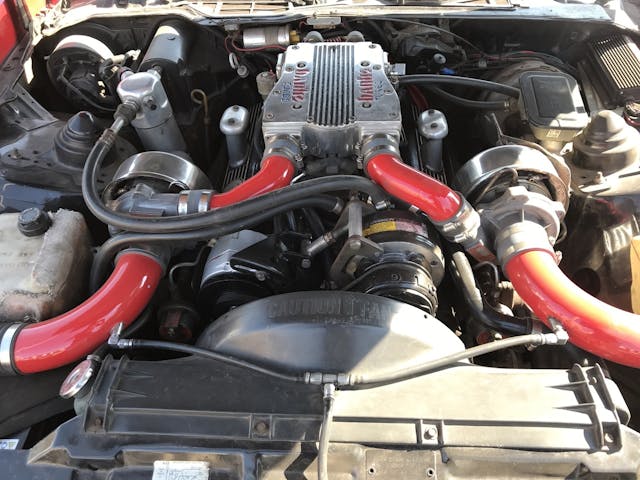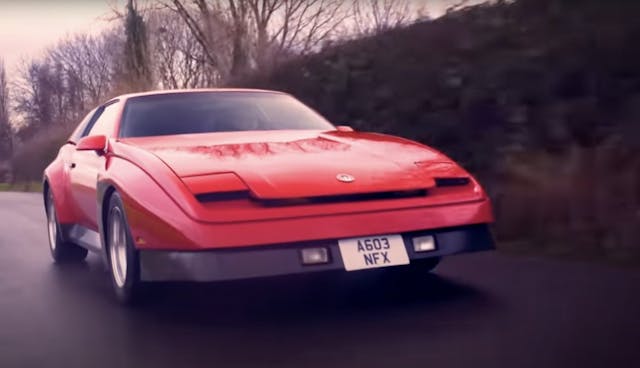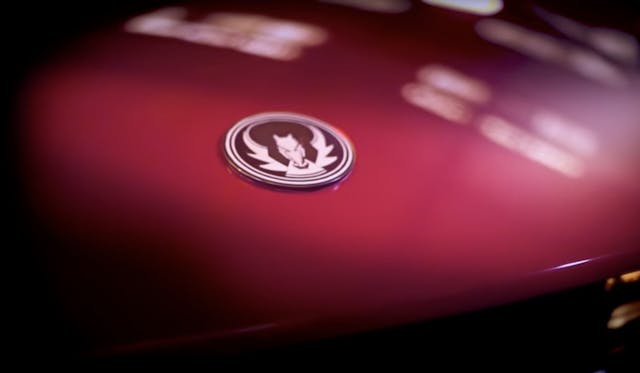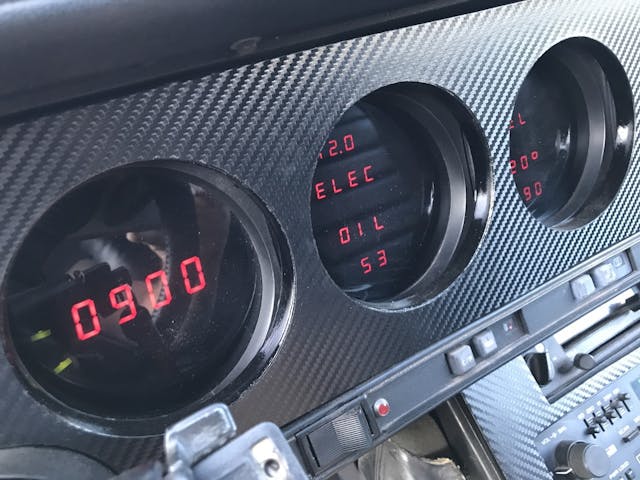Media | Articles
Pontiac Tojan: The Car That Beat Ferrari to 200 MPH
Forget what the car books and the Internet tell you. The first production car to hit the magic 200 mph mark didn’t come from Maranello, in the shapely silhouette of the impressive F40. It came from Nebraska, in the slightly more challenging shape of the Pontiac Tojan. And it was three whole years earlier than the annals of automotive history might have you believe. Forty years ago precisely, in fact.
Ask any petrolhead of a certain age—particularly those who were schoolchildren in the late ’80s—what the first “double century” was, and it’s always Ferrari’s homologation machine that gets the honors. Who can blame them? It’s what Google tells you, and it’s what the press of the time proudly heralded, which of course was then talked about far and wide and with great enthusiasm by those schoolchildren.
Which is all well and good, except for the fact that three years previous to this remarkable Italian achievement, another vehicle, one available from the showroom floor of selected Pontiac dealers, had already clicked past the magical 200 mph mark. And almost without a whisper in the wider press. This car was the Pontiac Tojan, America’s blue-collar precursor to the mighty Ferrari and one that was perhaps a little more affordable to most enthusiasts, at around a tenth of the F40’s $400,000 sticker price.


The Tojan story is an interesting one. Founded by Russ Knudsen in 1978, Knudsen Automotive began building “neoclassic” luxury cars along the lines of Great Gatsby–era pastiche designs like the Excalibur. The models were called the Baroque and were based on a GM G-body chassis and drivetrain to create a car that gave modern dynamics with classical styling. This small coachbuilder was keen to move with the times, however, and as the 1980s rolled around, Knudsen looked to see whether it could create something that suited the excessive aesthetic of the period, built once again on a GM-sourced chassis—and with the full blessing and support of the Detroit giant.
With the F-body Trans Am as his muse, Knudsen, alongside stylist Harry Bradley, penned his ideas for a svelte coupe, to be built from glass-reinforced plastic panels. The result is a hybrid construction that features a fiberglass hood, fenders, quarter panels, bumpers, and tailgate, built around the steel shell and doors of the Trans Am. If you squint a bit, you can very much still see the original car and its door swages peeking through, although the resulting design hangs together pretty well, in my humble opinion. Sketches were snail-mailed between Knudsen and Bradley, with little changes being made each way, until they’d managed to fine-tune the look of the thing. And whether you love or hate the final result, there’s no denying that it is both different and very representative of the design influences of the era.
Marketplace
Buy and sell classics with confidence

So, they had a design, they had a proven drivetrain, and in 1984 they were ready to press the button on a prototype. The very first car down the line, however, the car that would be used for all of those early motor show outings and brochure photoshoots, needed to hit a little harder, to make a noise in a sea of exotica, so Knudsen brought in fabled forced-induction guru and precision engine builder Gale Banks to create something truly special.
Banks had made a name turbocharging marine engines as far back as the late 1960s, but he also knew how to transfer that engineering prowess into a street-driveable motor. The solution he and Knudsen settled on? To simply drop Banks’ frankly insane, marine-proven 900-hp twin-turbo small-block V-8 into this first machine.

Still able to make a reliable 800 hp on pump fuel, the Tojan suddenly had what it took to create headlines and rock the supercar establishment. The resulting top speed run of this car allegedly took place on a very long, very straight road in Nebraska, easily clicking over 206 mph on the car’s digital speedo. Totally illegal. Totally unofficial. But there it was. The mythical double ton.
There may be a few of you at this point doubting Mr. Knudsen’s anecdotal evidence of this wild achievement, but when you start to examine what Banks was capable of—namely, creating a 1700 hp 454-cid V-8 that clocked 283 mph at a rainy Bonneville in another F-body Trans Am with minimal body mods—then it all starts to enter the realm of believability. Now, 800 hp is a lot of horsepower, and even with the glacial lag of those dustbin-sized turbos, you can imagine that with a road long enough, and a driver brave enough, it’s all decidedly possible. Sorry, Enzo…



So, what happened to these crazy machines? After the success and press splash of the prototype, Knudsen went on to sell another 135 cars, mainly through Pontiac dealers and distributors, and with wildly varying specs that reflected the more bespoke nature of the machines and the intended clientele. Many options were available, like the aforementioned digital dash, a huge Countach-esque rear wing, Recaro seats, Gotti split-rim wheels, and, within reason, anything the customer wanted. Prices ranged from $36,000 to $62,000—and with TV appearances in shows like Miami Vice, Alien Nation, and even the Jay Leno movie Collision Course, the car began to make a name for itself, and for its creators.
As is almost always the case with these endeavors, and being the boutique manufacturer that they were, the Tojan was never going to be a volume seller, however. With the exception of one supercharged build, not one customer was brave enough to tick the ‘nuclear’ option of the rather expensive, full-fat Banks motor, despite it being an option available on every car. This makes the 200mph car the only one of its kind ever made.

And what happened to that prototype, you ask? Believe it or not, it was shipped to an enthusiast in Poole, England, back in the mid-1980s, where it stayed up until a few years ago, when I was fortunate enough— perhaps persuasive enough—to add it to my collection. I’m delighted to say that Chassis #001 is still in the very rudest of health, although I can also attest that it probably hasn’t been within a sniff of 200 mph in a very long time. A previous engine rebuild many moons ago means that the choice Banks internals are no longer there, and although the car is still quite capable of picking up its skirts and going… eventually, thanks to all that lag, I’ve never been brave enough to drive it through the insane front end lift it generates at 140mph—where safe and legal to do so, of course. That’s plenty of speed for both a 40-year-old car and 50-year-old driver, anyway, don’t you think?
In this year of 40th anniversaries, it seemed only right to dust the old girl down for her celebration of four decades since this incredible first, and give her another moment in the sun. Our UK friends can expect to see the Tojan in pride of place at this year’s Radwood show, as well as in a slew of magazine and web features throughout the year. I may not have the official timing slip that the guys at Maranello got in 1987, but I’ve got Mr. Knudsen’s word as a gentleman, and Mr. Banks’ mark as an engineer, that I’ve got the world’s first 200-mph production car in the garage. And in my book, that’s even better.
***
Check out the Hagerty Media homepage so you don’t miss a single story, or better yet, bookmark it. To get our best stories delivered right to your inbox, subscribe to our newsletters.






























The hard part of hitting 200 mph is keeping the nose pointing down when it’s dropped out of the airplane. That is not a production car.
Is it no longer accepted that the 1969 Dodge Daytona was the first car to break 200mph? and it was available with the 426 from the dealer, which for decades has been accepted as making it a production car.
No proof that it ever did over 200 mph, so the F 40 Ferrari still holds the No. 1 slot. Not saying that it didn’t, only that there is no proof.
By the author’s own words: “This makes the 200mph car the only one of its kind ever made.” It was not a production car.
Greg the story left out the engine was a 200 MPH engine but the car that first did 200 MPH was a stock body Trans Am from Gale Banks.
https://official.bankspower.com/project/custom-projects/banks-pontiac-trans-am/200-mph-trans/
This one stock body door slammer broke 300 MPH in 1999
https://us.motorsport.com/general/news/lsr-pontiac-firebird-breaks-300-mph-at-bonneville/1768552/
Another Trans Am in 2021 broke 300 MPH.
The Trojan may have had the engine but the car never did 300 MPH. The body parts would have been thrown off and the nose is not down enough to not have had a ton of air under the car. It would be very undable if not undrivable.
Just a thought. What kind of tires were used for 200 mph run. Were ZR rated tires available back then?
Nope. They may have even been bias-ply.
Never let the truth get in the way of a good story.
What a fine bit of history. Who da thought! Well-written, too, thank you.
I remember seeing one of these in the 80s. They took a beautiful car and made it hideous. All wheel tuck and overhang. Looks like they put a Trans Am in a recycle bin.
Graphic proof that with enough horsepower, ANY vehicle can reach 200 mph.
The third gen T-shirt was the foundation for a lot of mods in the day.
People craved something, ANYTHING different than stock models.
A friend recently found a wide body Trans Am…with steel quarter panels.
He had done some research and apparently, some outfit made a few hundred which were sold, like our subject car, out of Pontiac dealers.
Sorry I can’t recall the name.
Then there was an option to replace the glass rear hatch with a flat piece and small, vertical tear window. Made it look a bit like the back of a Pantera.
Not as practical, but it had a unique look.
Finally, in the last days of Pontiac, the local dealer had one of those fifth gen Camaros with a Firebird body kit. If think it was labeled a “Bandit”. It was black and gold.
Not necessarily an improvement over the Camaro, but different.
With today’s homogenized, federalized, safetized cube-mobiles, being a bit different is enough.
Hot Rod Magazine put out an invite for the fastest cars that their readers owned. I a guy with a stock 1969 Dodge Daytona Charger painted by Earl Schibe to look like Petty’s ran 212 as I recall on street tires.
What a BEAUTIFUL car!
My memory serves to tell me that the Pantera of the early ’70’s had a speedometer showing 200MPH.
I have no personal knowledge of one attaining that, but I’ll bet they could, otherwise it would have been bad press.
Production cars, too.
This sure wasn’t a “production “ car. This was a one off hot rod. And with only hearsay evidence.
I think the article is interesting though cannot claim that this Pontiac was anything but not stock and certainly not a production car like Ferrari offered. Paul Cowland’s “Sorry, Enzo…” is just wrong and surprising for a Hagerty publication.